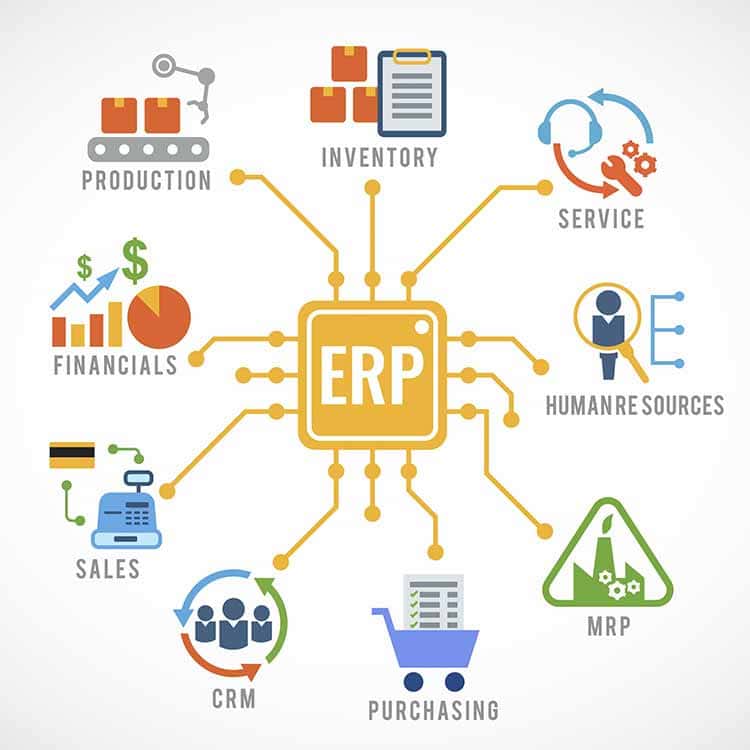-
Traditional ERP Can’t Solve Everything. Here’s What Else You Need To Make It Work
We often talk about ways that companies still using a manual system can transition to a digital platform. But what if your company automated years ago with traditional Enterprise Resource Planning (ERP) software? Is there any reason for you to look at newer, cloud-based Business Process Automation (BPA)?
ERP software solutions were a game-changer when they first came on the market. But they do have limitations. For one thing, traditional ERPs like NetSuite, SAGE, and QuickBooks lack flexibility. This limitation, and others, can become more and more of a problem as your company grows. The ERP is still great at letting you view and manage business processes in one place. It lets you to track employees, distribution, inventory, financial processes, customers, and more. However, it’s not going to work that well if you try to stretch it to do something it was never designed for like automating everyday accounts payable processing.
The good news is you don’t have to completely replace your existing ERPs to benefit from modern BPA. All of NextProcess’ Software as a Service (SaaS) systems, for example, are compatible with existing ERPs. Instead of overhauling your entire financial department, you can supplement your existing ERPs with flexible automation solutions that we can customize to solve the problems facing your business.

Limitations of ERPs
ERPs can’t do everything. They weren’t designed to. Even so, companies often try to stretch them past the limits. This often happened because there was not a better solution available at the time. The longer you use ERPs for things they weren’t meant to do, though, the more issues come up for your company to deal with. The most common issues with ERPs include
- Rigid Mechanisms – ERPs are often designed to create tightly locked databases and segregate responsibilities. In some ways, this is a great feature. But it can also leave you with confusing data and difficulty making sense of reports.
- Lack of Accessibility – granting remote access can be very difficult with an ERP. Even if you manage it, connection problems can slow down productivity. This is a particularly irritating problem now that more employees are working remotely since the pandemic started in 2020.
- Intake Problems – ERPs are good at solving back-end processes. However, moving information through ERP-driven workflow can be a challenge. Even a simple process like taking in documents sometimes presents a struggle.
- Missing Details – Fields used in an ERPs system often have specific meanings and limitations. Data transferred to and from ERPs might be stored in strange places or left out altogether. This problem is even more pronounced if you’re trying to run multiple ERPs or using ERPs with other software that’s not fully integrated into the system.
- Costly to Change – Adjusting an ERP system is typically both difficult and expensive, especially if you want to make significant operational changes. That often makes upgrading or changing ERPs to meet your companies growing needs impractical.
- Difficult to Integrate – ERP systems don’t often support integration with other software and many IT professionals don’t have the experience and knowledge needed to fully integrate software. Most integrations end up operating at a standardized level that doesn’t match every company’s unique needs.
If you’re having trouble with your ERPs, don’t panic. You can still get the most out of your existing ERP system (or systems) by integrating it with dynamic, adaptable SaaS technology.
How To Fix It
Software integration is the best solution to an ERP that’s not working out as well as you’d like. When you integrate SaaS systems into your use of ERP, they give you more control over automating your business processes. It also makes the entire system more user-friendly.
- Add Automation – BPA software fills in the gaps left by your ERPs. The ERP runs things on a big-picture, back-end process level. BPAs streamline and optimize workflow within individual departments. For example, automation speeds up Microsoft Dynamics AX Accounts Payable workflow. It also reduces errors and fraud in T&E, and automatically enforces purchasing policies.
- Work with the Right Partner – since ERPs aren’t always easy to integrate, you want to make sure the software partner you’re working with has experience completing integration successfully. Here at NextProcess, we have a 100% success rate integrating with ERP software.
- Use One Automation Partner – when possible, use BPA software that comes from the same supplier. There are many advantages to using a software suite when automating different business processes such as accounts payable, purchasing, travel and expense reporting, and capital expenses. One of those advantages is that it’s easier ERP integration. You’ll also eliminate the risk of BPA software incompatibility.

By partnering with a reliable supplier to add business process automation to your ERPs, you’ll be able to solve many of the processing issues challenging your company. Good BPA software will give you more flexibility and customization options while cutting costs and increasing data security.
See How NextProcess Can Help
Don’t settle for ERP software that limits your company. Get in touch with NextPrcess and work with a dynamic technology supplier to resolve outstanding ERP issues and improve business processes across the board. We provide an online platform with several software modules that improve workflow, increase turnaround time, decrease staffing needs, and more. Choose from our Accounts Payable, Purchase Order, T&E, CapEx, Document Management, and disbursement solutions or use multiple systems together.
We designed all our software to work with ERPs including SAP, Oracle, Microsoft Dynamics, Sage, Netsuite, Epicor, Intuit Quickbooks, and many more. When you choose NextProcess, we’ll work with you to make sure our software solutions integrate seamlessly with your ERPs in exactly the ways you need them to. We also don’t stop with fully integrated software solutions. We spend months working alongside your company optimizing and customizing our software to make sure it fits your company’s needs exactly. Contact us today if you’d like to see how SaaS can upgrade your ERP experience.
